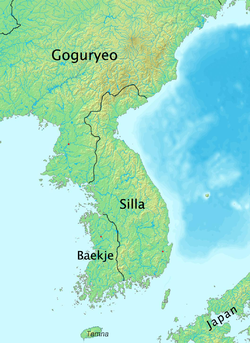Silla
Silla 신라 (新羅) | |||||||||||
|---|---|---|---|---|---|---|---|---|---|---|---|
| 57 BC–935 AD | |||||||||||
 Pre-Later Silla at its hicht in 576. | |||||||||||
| Caipital | Gyeongju (Geumseong, then Seorabeol) | ||||||||||
| Common leids | Sillan leid | ||||||||||
| Releegion | Buddhism, Confucianism, Taoism, Shamanism (Sindo) | ||||||||||
| Govrenment | Monarchy | ||||||||||
| Keeng | |||||||||||
• 57 BC – 4 | Hyeokgeose (first) | ||||||||||
• 540–576 | Jinheung | ||||||||||
• 654–661 | Muyeol | ||||||||||
• 661–681 | Munmu | ||||||||||
• 681–692 | Sinmun | ||||||||||
• 927–935 | Gyeongsun (last) | ||||||||||
| History | |||||||||||
• Establishment | 57 BC | ||||||||||
• Introduction o Buddhism | 530 | ||||||||||
• Campaigns o King Jinheung | 551–585 | ||||||||||
| 668–935 | |||||||||||
• Haundower tae the Goryeo | 935 AD | ||||||||||
| Population | |||||||||||
• 7t century[1] | 894,680 | ||||||||||
• 8t century[1] | 2,000,000 | ||||||||||
| |||||||||||
| The day pairt o | |||||||||||
| Silla | |
| Hangul | |
|---|---|
| Hanja | |
| Revised Romanisation | Silla |
| McCune–Reischauer | Silla |
Silla (57 BC[note 1] – 935 AD) (Korean pronunciation: [ɕilːa]) wis ane o the Three Kinricks o Korea, an ane o the warld's langest sustained dynasties. Altho it wis foondit bi King Pairk Hyeokgeose, the dynasty wis ruled bi the Gyeongju Kim (김, 金) clan for maist o its 992-year history. What began as a chiefdom in the Samhan confederacies, ance allied wi Cheenae, Silla eventually conquered the ither twa kingdoms, Baekje in 660 an Goguryeo in 668. Thareefter, Unified Silla or Later Silla, as it is eften referred tae, occupied maist o the Korean Peninsula, while the northren pairt re-emerged as Balhae, a successor-state o Goguryeo. Efter nearly 1000 years o rule, Silla fragmented intae the brief Later Three Kinricks, haundin ower pouer tae its successor dynasty Goryeo in 935.[2]
Notes
[eedit | eedit soorce]- ↑ 57 BC accordin tae the Samguk Sagi; houiever Seth 2010 notes that "these dates are dutifully given in many textbooks and published materials in Korea today, but their basis is in myth; only Goguryeo can be traced back to a time period that is anywhere near its legendary founding."
References
[eedit | eedit soorce]- ↑ a b 박용운 (1996). 고려시대 개경연구 147~156쪽.
- ↑ http://www.shilla.or.kr/shilla_culture/ Archived 2008-03-21 at the Wayback Machine Retrieved on 2008-03-08

